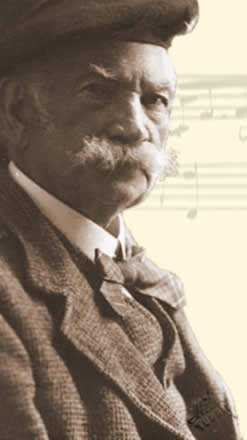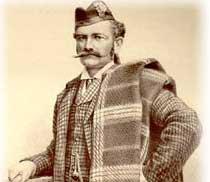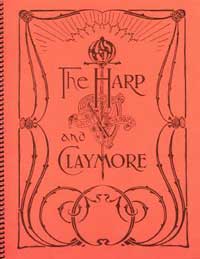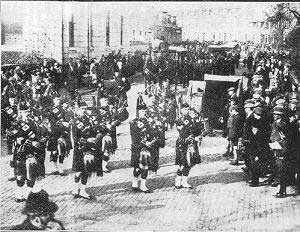James Scott Skinner
(1843-1927)
 The musical marriage between the violin and the bagpipe has been a long and fruitful one, and no fiddler contributed more to the piping repertoire than James Scott Skinner.
The musical marriage between the violin and the bagpipe has been a long and fruitful one, and no fiddler contributed more to the piping repertoire than James Scott Skinner.
He was born in Banchory, a village 20 miles from Aberdeen, on August 5, 1843. His father William had been a full-time gardener and part-time fiddler, but when he lost three fingers on his left hand in a gun accident, he gave up gardening, switched his bowing to the left hand and became a full-time fiddler and dance master. He died when James was only 18 months, so his influence on him was indirect and passed on mostly through his family.
Alexander (Sandy), the eldest of James’s five brothers, taught James violin and cello when he was 6. By the time he was 8 he was playing the cello for pay in local shows with violinist Peter Milne.
 At age 12 he joined “Dr. Mark’s Little Men,” a boys’ group that performed throughout the British Isles and played for Queen Victoria at Buckingham Palace. He continued to study violin from respected masters, including French violinist Charles Rougier, and later dancing master William Scott, for whom it is thought he changed his middle name to ‘Scott’ and became known thereafter as Scott Skinner.
At age 12 he joined “Dr. Mark’s Little Men,” a boys’ group that performed throughout the British Isles and played for Queen Victoria at Buckingham Palace. He continued to study violin from respected masters, including French violinist Charles Rougier, and later dancing master William Scott, for whom it is thought he changed his middle name to ‘Scott’ and became known thereafter as Scott Skinner.
In 1862 he won first prize in the Sword Dance at the Ireland Highland Dance Competition, garnering particular attention by being able to dance to his own fiddling. After this he turned to country dance teaching. In 1863 he won a strathspey and reel competition in Inverness for fiddling.
By 1868, at 25, he was teaching dancing to more than 100 children at the palace at Balmoral, taught violin privately and performed both classical and traditional music, including his own growing number of compositions.
He married Jean Stewart in 1871, with whom he had two children. Jean would later suffer from severe mental illness, be admitted to an asylum in 1885 and die there in 1899, supported by Skinner when he himself wasn’t broke. The year Jean died he married Gertrude Mary Park, who would subsequently “resign” from the post and leave him in 1909 to move to Rhodesia. These events only hint at what has been described more than once as the ‘mess’ that was Scott Skinner’s personal life. Despite his ability to command high prices as a performer, the cost of his ambitious publications frequently pushed him to or close to bankruptcy. He lived much of his life in hotels, or with friends, and it was only in 1922 at the age of 79 that he was able to buy a home in Aberdeen and settle into domesticity with his housekeeper, Lily Richards.

By 1893 he had published half a dozen books of music, and that year he departed for a performing tour in the United States with piping and dancing master William MacLennan, cousin of piper G. S. McLennan. The tour collapsed when MacLennan died suddenly of meningitis in Montreal – one of piping’s great tragic losses – and the performers were left to fend for themselves and find their own ways home.
The influence of this tour on Skinner was life-changing. On his return, he decided to give up dance teaching for good, perform and publish full time, and adopt Highland dress for all of his stage performances. In his autobiography My Life and Adventures, he would say of this time:
When I returned from America I made up my mind on two points. Firstly, I decided to have done with dancing. As a solo violinist I decided to stand or fall. Secondly, I decided to make the kilt my platform dress…. With the exception of myself, there was no Scottish violinist of any eminence at this time…. Success happily crowned my endeavours, and, with its realisation, I bitterly resented the many years I had wasted as a country dancing master.
Such statements were not untypical of the man who declared himself “The Strathspey King.” Yet, as poorly as he managed his life, so did his music soar. By 1909 he had published 10 books of music and instruction as well as a number of sets of sheet music. In 1899 he had begun to record his music on wax cylinders – one of the first Scottish artists to be recorded. This aspect of his career would continue until 1922 and spread his fame worldwide.
Click here to listen to Skinner play his strathspey “The Laird of Drumblair”.
As a professional performer we was popular but isolated – classical performers even in Scotland despised Scottish fiddlers, and few if any others like him could survive on their music alone. Following his own personal motto “Talent does what it can, genius does what it must,” he poured his earnings back into publishing and frequently courted poverty. By the 1920s his output of compositions approached 700 tunes; these were an expression of technique and emotion his personality never equalled. “The Bonny Lass of Bon Accord” remains one of the great compositions for Scottish fiddle.
He embraced bagpipe music, and with tunes such as “The Laird of Drumblair,” “The Cameron Highlanders,” “The Left-Handed Fiddler,” “Stirling Castle,” “The Piper’s Weird,” and “Hector the Hero,” he became the most popular fiddler in piping. His piping friends included no less than the great G. S. McLennan, who wrote “The Strathspey King” – one of the best two-parted strathspeys in the idiom – after him.

When Skinner died in Aberdeen on March 17, 1927, the Aberdeen Police Pipe Band led the funeral cortege, 40,000 people lined the streets, and G. S. McLennan played at the graveside.
His musical legacy remains for fiddlers and pipers alike, with many a piper playing classic pipe tunes tunes they have no idea were written by one of the greatest Scottish fiddlers.
JM, September 2007
-with notes from Wikipedia, Highland Heritage Society Biographies, the Musical Traditions website, The University of Aberdeen website, Folkworld and “The Strathspey King,” published by Temple Records 2002, COMD2084.

4 Comments
Yes, J.S Skinner was a genius, I knew several pipe tunes from his composition, but I’ m amazed of the so many tunes from him
Hat’s off Strathspey king
Jean Michel Platen , in France ( from Brittany )
I would like to know if you have any information on William Ross Pope Major to Queen Victoria. He was my great great uncle. I have found a few articles about him but wondered if there has been anything such as a biography Thank you , Mary
Hi Mary: I don’t have a bio on Wm Ross. You’ve probably seen many photos of him online. If you can lay your hands on “The Highland Pipe and Scottish Society: 1750-1950” by Dr. William Donaldson he devotes much of a chapter to William Ross. JM
Well Jim, I am interested to read that Scott Skinner recorded on ‘wax cylinders’ in 1899. As I am aware, his first and only cylinders were for Sterling in 1906-8, and his earlier recordings were all on DISC — not even wax — in particular a small set of 7″ discs recorded for the Gramophone Company in Glasgow in September 1899. So where did this throw-away snippet come from? It rather looks as if you have quoted from someone’s usual careless assumption, that early recordings were all on cylinder, which is very patently untrue (think HMV trademark, also 1899).
See Bill Dean-Myatt’s enormous published volume of Scots-related recordings on cylinders and 78s:
https://www.worldcat.org/title/scottish-vernacular-discography-1888-1960/oclc/835971350
and also the online Kelly database of Gramophone/HMV/EMI 78s: https://www.kellydatabase.org/